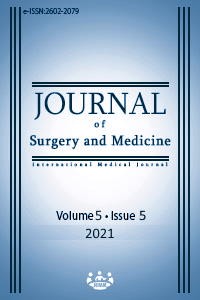Different fresh gas flows in prone position under general anesthesia: comparison of costs and effects on airway and endotracheal cuff pressures
Keywords:
Low-flow anesthesia, Prone position, General anesthesia, SevofluraneAbstract
Background/Aim: Many studies have been performed on different fresh gas flows for general anesthesia. In this study, we aimed to compare the costs, airway, and endotracheal cuff pressures of different fresh flows (low, medium, high) of patients receiving general anesthesia in the prone position. Methods: A total of 150 ASA I-II patients over the age of 18 years who underwent lumbar vertebral surgery in prone position were included in this retrospective cohort study. Patients were divided into three groups: Low-flow (n=50, fresh gas flow: 1 l/min), medium-flow (n=50, fresh gas flow: 2 l/min) and high-flow (n=50, fresh gas flow: 4 l/min). In addition to the preoperative heart rates, peripheral oxygen saturation, mean arterial pressures, endotracheal cuff pressures, airway peak and plateau pressures in the first 60 minutes (as 0th, 15th, 30th, 45th, 60th minutes) were noted, and the amount of inhaled gases (sevoflurane, oxygen, nitrogen protoxide) based on the data of the device were recorded to evaluate cost. Results: The two groups were similar in terms of hemodynamics, airway, and endotracheal cuff pressures. Regarding cost, there was a significant difference in the low-flow anesthesia group in terms of inhaled anesthetic agents, oxygen, and nitrogen protoxide. Conclusion: With modern anesthesia machines, it is unnecessary to avoid low-flow anesthesia applications. However, we recommend that the fresh gas flow be more than 2 l/min for anesthetists lacking experience or those who do not prefer low-flow anesthesia.
Downloads
References
Baker AB. Low flow and closed circuits. Anaesth Intensive Care. 1994;22:341-2. doi: 10.1177/0310057X9402200402.
Baum JA, Aitkenhead AR. Low-flow anaesthesia. Anaesthesia. 1995;50:37-44. doi: 10.1111/j.1365-2044.1995.tb06189.x.
Vecil M, Di Stefano C, Zorzi F, Saltarini M, De Monte A. Low flow, minimal flow and closed circuit system inhalational anesthesia in modern clinical practice. Signa vitae. 2008;3:33-6.
Baum J. Niedrigflußnarkosen. Anaesthesist. 1994;43:194-210. doi: 10.1007/s001010050049.
Kılıç Y. A Reminder to Anesthesiologists: Low-Flow Anesthesia. J Clin Anal Med 2016;7:183-5.
Hendrickx JF, De Cooman S, Vandeput DM, Van Alphen J, Coddens J, Deloof T, et al. Air-oxygen mixtures in circle systems. J Clin Anesth 2001;13:461-4. doi: 10.1016/s0952-8180(01)00303-8.
Kennedy RR, Hendrickx JF, Feldman JM. There are no dragons: Low-flow anaesthesia with sevoflurane is safe. Anaesth Intensive Care 2019;47:223-5. doi: 10.1177/0310057X19843304.
McGain F, Bishop JR, Elliot-Jones LM, Story DA, Imberger GL. A survey of the choice of general anaesthetic agents in Australia and New Zealand. Anaesth Intensive Care 2019;47:235-41. doi: 10.1177/0310057X19836104.
Chatrath V, Khetarpal R, Bansal D, Kaur H. Sevoflurane in low-flow anesthesia using "equilibration point". Anesth Essays Res 2016;10:284-90. doi: 10.4103/0259-1162.172343.
Doger C, Kahveci K, Ornek D, But A, Aksoy M, Gokcinar D, et al. Effects of Low-Flow Sevoflurane Anesthesia on Pulmonary Functions in Patients Undergoing Laparoscopic Abdominal Surgery. Biomed Res Int 2016;2016:3068467. doi: 10.1155/2016/3068467.
Isik Y, Goksu S, Kocoglu H, Oner U. Low flow desflurane and sevoflurane anaesthesia in children. Eur J Anaesthesiol 2006;23:60-4. doi: 10.1017/S026502150500178X.
Kupisiak J, Goch R, Polenceusz W, Szyca R, Leksowski K. Bispectral index and cerebral oximetry in low-flow and high-flow rate anaesthesia during laparoscopic cholecystectomy - a randomized controlled trial. Wideochir Inne Tech Maloinwazyjne 2011;6:226-30. doi: 10.5114/wiitm.2011.26256.
Bahar S, Arslan M, Urfalioglu A, Gisi G, Oksuz G, Bilal B, et al. Low-flow anaesthesia with a fixed fresh gas flow rate. J Clin Monit Comput 2019;33:115-21. doi: 10.1007/s10877-018-0135-2.
Toal P, Chiplonkar S, Panchal P. A randomised prospective comparison of equilibration point and changing gas composition during low-flow anaesthesia with sevoflurane vs desflurane. Indian J Anaesth 2019;63:814-19. doi: 10.4103/ija.IJA_31_19.
Ip-Yam PC, Goh MH, Chan YH, Kong CF. Clinical evaluation of the Mapleson theoretical ideal fresh gas flow sequence at the start of low-flow anaesthesia with isoflurane, sevoflurane and desflurane. Anaesthesia 2001;56:160-4. doi: 10.1046/j.1365-2044.2001.01835.x.
Horwitz M, Jakobsson JG. Desflurane and sevoflurane use during low- and minimal-flow anesthesia at fixed vaporizer settings. Minerva Anestesiol 2016;82:180-5.
Bilgi M, Goksu S, Mizrak A, Cevik C, Gul R, Koruk S, et al. Comparison of the effects of low-flow and high-flow inhalational anaesthesia with nitrous oxide and desflurane on mucociliary activity and pulmonary function tests. Eur J Anaesthesiol 2011;28:279-83. doi: 10.1097/EJA.0b013e3283414cb7.
Feldman JM. Managing fresh gas flow to reduce environmental contamination. Anesth Analg 2012;114:1093-101. doi: 10.1213/ANE.0b013e31824eee0d.
Baum JA. Low-flow anaesthesia. Eur J Anaesthesiol 1996;13:432-5. doi: 10.1097/00003643-199609000-00002.
Odin I, Feiss P. Low flow and economics of inhalational anaesthesia. Best Pract Res Clin Anaesthesiol 2005;19:399-413. doi: 10.1016/j.bpa.2005.01.006.
Feldman JM, Lo C, Hendrickx J. Estimating the Impact of Carbon Dioxide Absorbent Performance Differences on Absorbent Cost During Low-Flow Anesthesia. Anesth Analg 2020;130:374-81. doi: 10.1213/ANE.0000000000004059.
Therapeutic Goods Administration Sevoflurane – product information. Oct 2018. https://www.ebs.tga.gov.au/ebs/picmi/picmirepository.nsf/pdf?OpenAgent&id=CP-2012-PI-01017-3 Accessed 09 Jun 2020.
Downloads
- 193 542
Published
Issue
Section
How to Cite
License
Copyright (c) 2021 Ahmet Gültekin, Ayhan Sahin, İlker Yıldırım, Cavidan Arar
This work is licensed under a Creative Commons Attribution-NonCommercial-NoDerivatives 4.0 International License.
















